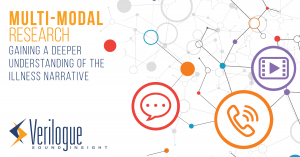Ethnographic research provides a rich window into the drivers, barriers and influencers that affect consumer health decisions and behaviors. As patients are gaining more influence over the selection of products and services, healthcare must shift focus towards understand and promoting positive and sustainable behavior change at the consumer level. In-home ethnographic research provides a consumer level view, offering a much clearer and more holistic view of how a product and condition fits within a patient’s lifestyle. At Verilogue, we work with your team to develop a custom ethnographic research program to help achieve your team’s research objectives. Contact us today for your next ethnographic market research project.
ETHNOGRAPHIC RESEARCH
Observing the actions, behaviors, and emotions of patients in their natural environment
Learn about the cultural differences and dynamics that impact your customers’ perceptions and behaviors.
Go beyond the patient and develop a deep human understanding of what it means to live with a condition.
Engage and understand the patient journey across many different countries, cultures, and conditions.
Ground your marketing efforts in the reality of the human experience.
More about our Ethnographic Research
Check out our content below
WEBINAR: Differences in Cultural Communication
Across the world, people communicate very differently with each other, and especially their physicians. What one culture might use to describe high levels of pain could have an entirely different meaning in another country. Whether it be different countries, religions, or races, people commonly stick to communicatory patterns when speaking about their health in their natural language. While these differences can have a negative impact on the patient during the diagnosis and treatment stage, there are opportunities for brands to support these patients locally and globally.

CASE STUDY: Multi-Modal Research
For most brand teams, insights arising from dialogue research provide the level of understanding required to bridge critical communication gaps. Occasionally, teams will want an even deeper understanding of the patient illness narrative. While the conversations captured in the physician’s office are critical, additional and valuable insight can be gained from an analysis of other conversations patients are having.


